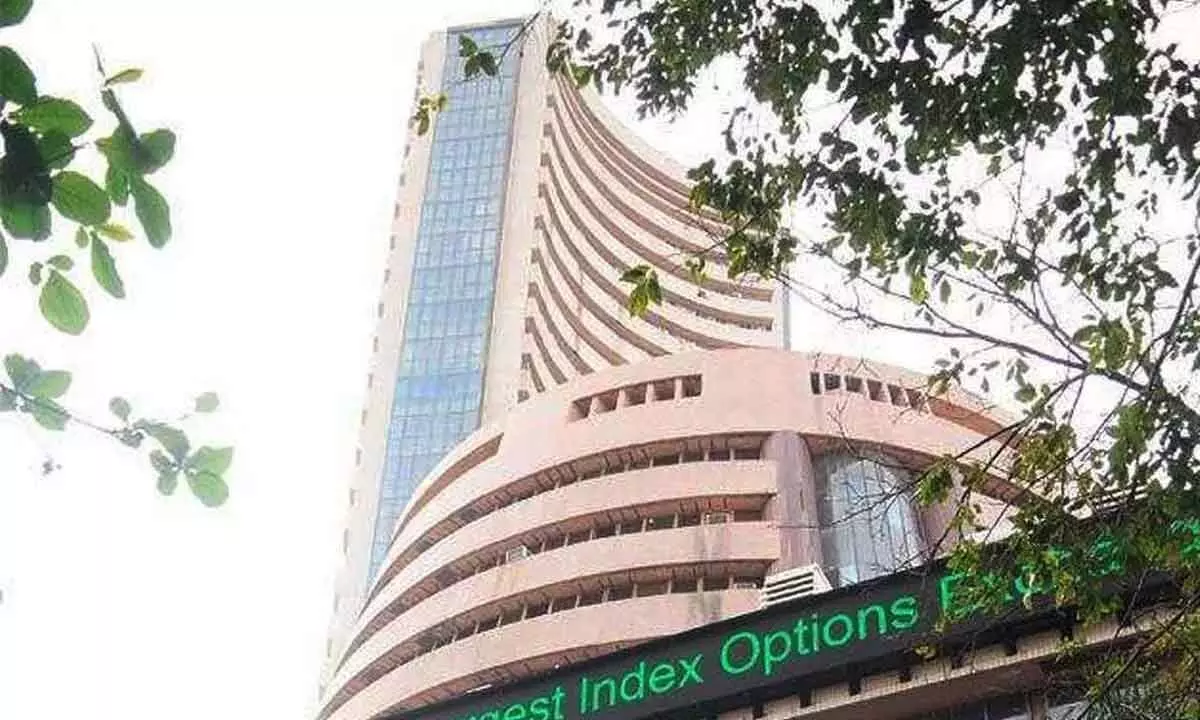Markets losing steam amid weak global cues

BSE Sensex
Amid rising US dollar on fears of aggressive policy tightening by Fed, FIIs net sold `1,900-cr worth shares and DIIs offloaded shares worth `2,900 cr last week, turning the sentiment negative
Spooked by the rising expectations of aggressive rate hikes from the US Fed in the upcoming policy meetings to control inflation, spike in US dollar index and bond yields; the domestic benchmark indices closed with more than 1.5 percent loss for the week ended. BSE Sensex plunged more than 950 points to 58,841 points, and NSE Nifty fell a little more than 300 points to 17,531 points. In the broader market, the Nifty Midcap index fell 1.7 percent and Smallcap 100 index slipped 1.2 percent. Amid rising US dollar on fears of aggressive policy tightening by Fed, FIIs have net sold Rs1,900 crore worth of shares and DIIs offloaded shares worth Rs2,900 crore in the week gone by, turning the sentiment negative.
Indian markets have shown tremendous strength till date in comparison with other markets across the globe. However, the lingering fear of aggressive rate hikes by the US Fed has capped the upside and also triggered fresh sales. With volatility and consolidation expected to continue in the coming few weeks, stay light on positions and trade cautiously advise old timers. The Central Government's National Logistics Policy aimed at facilitating a unified regulatory environment and institutional framework governing the sector is expected to help the property sector capitalize on the exponential growth of commercial real estate including warehousing and industrial Parks across both established and emerging logistics markets. The warehousing and logistics segment of real estate, which has emerged as relatively immune to the shocks of Covid-19, is expected to gain further strength and attract more investment in the next couple of years. Near term direction of the market will be dictated by US Fed policy decisions, international crude oil prices, dollar index moves, macroeconomic data and geo-political developments. The market is expecting a 75bps rate hike in Fed's meeting next week. Inflation trackers don't rule out 100 bps hike that could dampen equity markets sentiment significantly. Track Fed's commentary and forward guidance to gauge direction of the market in the coming weeks. Stay stock-specific and selective in the approach, avoid excessive leverage, and remain moderate and light on the overall exposures. A cautious approach is advised for the coming week.
Listening Post: Markets almost always misprice the obvious. That's worth bearing in mind as you think about the stock market's nerve-racking decline this week. It's worth remembering as you size up the behaviour of stocks in the rest of the world, too. Stock prices impound the expected. If the future unfolds according to the consensus, markets won't move much. Surprise is the source of extra returns, magnifying gains and losses alike. Enterprising investors—those who are willing to put time and effort into diverging from the crowd—should always be thinking about where the potential for surprise is the greatest. The economic news on global front is dismal, currencies are crippled and returns have been rotten for years. Things are likely to get even worse before they get better. Europe is caught up in a war that could escalate without warning or limit—as well as an energy crisis that's all, but certain to cause a severe recession. Fierce energy inflation will also make European manufacturers less competitive. Japan, hobbled by a geriatric population, has been sluggish for years. In China, economic growth is shrivelling as the nation fights Covid and tries to manage the collapse of its formerly feverish real-estate market. Other emerging markets are suffering from the soaring costs of energy and food. Meanwhile, the US dollar is dominant. The dollar is near its highest value relative to the Japanese yen in a quarter-century; it recently rose past the euro for the first time in two decades. A rising dollar generally means falling returns on stocks denominated in other currencies; a falling dollar tends to raise returns. Results for emerging markets have been even worse. When economies are slowing and earnings have been poor, that's driven down currencies in tandem. Investors who held the equities and currencies together have gotten whacked with two clubs at the same time. At this point, it's obvious: International shares are priced for almost nothing, but negativity. As humans, we like to look in the rear-view mirror, and what has worked is always more appealing than what should work. Turning your back on Indian stocks today, however, is a bet that their lousy performance is pretty much permanent. And not many things in markets last indefinitely. The obvious negatives are already priced in: a prolonged war in Ukraine, an acute energy crisis and raging inflation, a brutal recession, floundering currencies. With pessimism this pervasive, it wouldn't take many positive surprises to overturn the obvious. Stay invested in is the mantra of global investors.
Quote of the week: "With a good perspective on history, we can have a better understanding of the past and present, and thus a clear vision of the future." — Carlos Slim Helu
It's far too easy for investors to lose perspective. Whenever something big goes wrong, a lot of people panic and sell their investments. Looking at history, the markets recovered from the 2008 financial crisis, the dotcom crash, and even the Covid pandemic, so they'll probably get through whatever comes next as well.
F&O/ SECTOR WATCH
On the back of heightened volatility and down move in US market; the derivatives segment witnessed sharp moves in stock Futures. Option data indicates maximum Call Open Interest (OI) at 18,000 strike, followed by 18,500 strike and the maximum Put OI is at 16,500 strike, followed by 17,500. Traders expect 18,000 to act as a crucial resistance and 17400 to be support level. Nifty may move in the range of 17,300-17,800 levels in the near term, while the broader trading range could be 17,000 to 18,000 levels. India VIX, which measures the expected volatility in the market, rose 11.85 percent during the week to 19.82 levels. Put-Call ratio (PCR) has slipped to an oversold level of 0.76; bounceback triggered by short covering from current level is not ruled out. Sectorally, IT fell seven percent sharply this week following the rout in global tech stocks, followed by auto, FMCG, oil & gas, pharma, and realty stocks, but banks and metals stocks bucked the trend. Sources indicate that a unit of Sony Group and Zee Entertainment have proposed offering concessions such as pricing discounts to help ease concerns of the country's antitrust regulator CCI over their merger, which will create a $10-billion TV behemoth. Surprising sharp rally indicated in Zee in next few weeks. In telecom space, Jio and Airtel further widened their respective market shares to 36.23% (36%) and 31.66% (31.63%) over the previous month, while Vodafone-Idea's share narrowed to 22.22% (22.37%). Market players are expecting a major announcement on Vodafone. Speculative gains likely. In the auto space backend ancillaries like Bharat Forge, Amara Raja and Exide are likely to report good Q2 numbers. Buy at current levels. Stock Futures looking good include AU Small Finance, Astral, InduSind Bank, PFC, Sun TV and Tata Power. Stock Futures looking weak are Balkrishna Inds, Glenmark, LTTS, Lupin and Vedanta.













